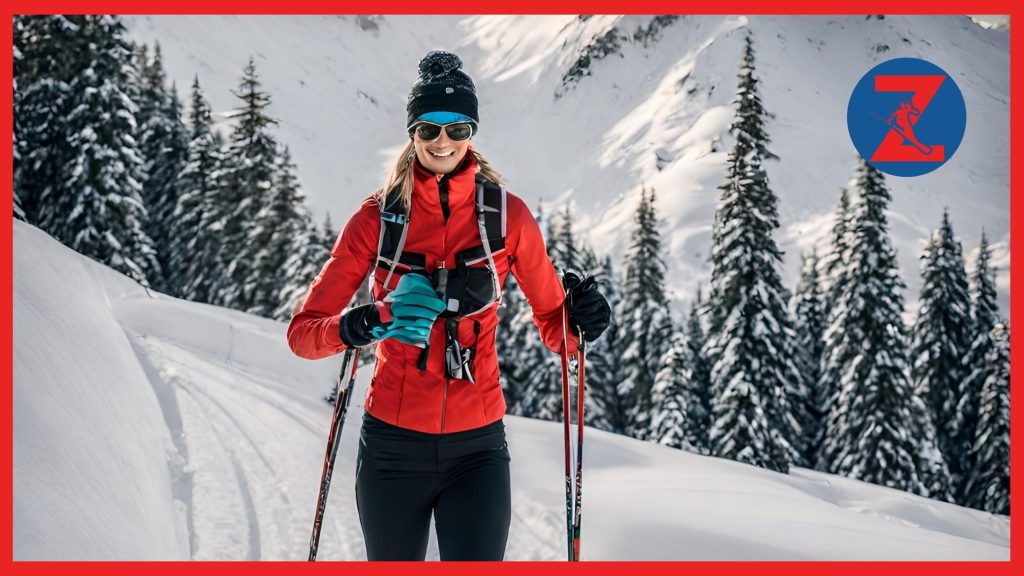Are you ready to embark on an exhilarating winter adventure that combines outdoor exploration and physical fitness? Look no further than cross-country skiing! With its serene landscapes and cardio-boosting benefits, cross-country skiing is a popular winter sport that caters to individuals of all fitness levels. But before you hit the trails, it’s important to familiarize yourself with the cross-country ski gear essentials and master the correct skiing technique. Are you ready to glide gracefully through the snow-covered trails? Let’s get started!
Getting Started with Cross Country Skiing

If you’re new to cross country skiing, this section will provide you with the information you need to get started. Whether you’re seeking a fun outdoor activity or looking for a low-impact workout, cross-country skiing is a fantastic way to enjoy the winter months.
Types of Cross Country Ski Equipment
Before hitting the trails, it’s essential to understand the different types of cross-country ski equipment available:
- Ski Boots: Choose boots that provide good ankle support and a comfortable fit. Look for boots specifically designed for cross-country skiing to ensure proper performance on varied terrain.
- Skis: Cross-country skis are typically longer and narrower than downhill skis, allowing for efficient gliding on flat or gently rolling terrain. They come in different styles, including classic skis (for traditional striding motion) and skate skis (for a skating-like motion).
- Poles: Poles help with balance and propulsion while skiing. They should be lightweight, strong, and correctly sized for your height and skiing style.
- Bindings: Bindings attach your boots to the skis. Ensure that your bindings are compatible with your boots and that they offer a secure connection for optimal skiing performance.
- Clothing: Dress in layers to stay warm and dry during your cross country skiing adventures.
Basic Cross Country Ski Training
While cross country skiing can be gentle on the joints, it still requires some level of fitness and technique. Here are some essential training tips to improve your skills on the snow:
- Cardiovascular Fitness: Engage in activities like running, cycling, or swimming to improve your cardiovascular endurance, which will make skiing for longer distances easier.
- Strength Training: Focus on strengthening your legs, core, and upper body to enhance your skiing performance. Exercises like squats, lunges, planks, and rowing can be beneficial.
- Balance and Coordination: Incorporate exercises that challenge your balance and coordination, such as yoga or stability exercises, to improve your stability and control while skiing.
- Practice Technique: Take the time to learn and practice proper cross country ski technique. Attending lessons or clinics can help you refine your skills and prevent injury.
“Cross country skiing engages the entire body, making it an excellent full-body workout that improves cardiovascular endurance and builds strength.”
Remember to start slowly and gradually increase the intensity and duration of your ski sessions to prevent overexertion or injury.
| Tip | Description |
|---|---|
| Warm Up and Cool Down | Perform a dynamic warm-up before skiing to prepare your muscles and joints. After skiing, cool down with stretching exercises to prevent muscle stiffness. |
| Hydration and Nutrition | Stay hydrated and fueled by drinking water and consuming nutritious snacks before, during, and after your ski sessions. |
| Safety First | Be aware of your surroundings, ski on marked trails, and dress appropriately for the weather conditions. Carry a map, phone, and other safety essentials. |
By familiarizing yourself with the different cross country ski equipment and following basic training guidelines, you’ll be well-prepared to embark on your cross country skiing journey. So, gear up and get ready to experience the thrill of gliding through snow-covered landscapes!
Mastering Cross Country Ski Techniques

To truly enjoy the sport of cross country skiing, it’s essential to master the different techniques. In this section, we’ll delve into the various skiing techniques, including classic and skate skiing, as well as discuss the benefits of nordic skiing.
Classic Skiing Technique
Classic skiing, also known as traditional or diagonal stride skiing, is the most common technique used in cross country skiing. It involves a coordinated movement of striding and gliding on groomed tracks. To execute the classic skiing technique, skiers use parallel tracks to push off with one ski while gliding forward on the other. This movement creates a fluid motion that propels skiers across the snow-covered terrain.
Skate Skiing Technique
In contrast to classic skiing, skate skiing is a faster and more dynamic technique that resembles ice skating. The skier moves in a diagonal pattern, pushing off with the inside edge of one ski while simultaneously gliding forward with the other ski. Skate skiing requires a strong upper body engagement, with skiers using their poles to provide additional power and momentum.
The Benefits of Nordic Skiing
“Nordic skiing offers a myriad of benefits for both physical and mental well-being. It is a low-impact, full-body workout that engages major muscle groups and improves cardiovascular fitness. The rhythmic movements of cross country skiing promote coordination, balance, and core strength. Additionally, the serene and tranquil winter landscapes provide a peaceful and rejuvenating experience for the mind and soul.”
Whether you prefer the timeless elegance of classic skiing or the thrill of skate skiing, mastering the techniques of cross country skiing opens up a world of possibilities for outdoor adventures. Each technique offers its own unique challenges and rewards, allowing you to explore new terrains and push your limits. So, grab your skis, embrace the snowy trails, and indulge in the exhilaration of nordic skiing.
The Best Cross Country Skiing Trails
Embark on an unforgettable winter adventure and explore some of the most breathtaking cross country ski trails around the world. Whether you’re a beginner or an experienced skier, these cross country ski destinations offer a variety of terrains and stunning landscapes to enjoy.
Scenic Mountain Routes
For those seeking a thrilling cross country skiing experience, head to the majestic mountains of Colorado’s Rocky Mountain National Park. With its challenging trails and awe-inspiring views, this destination promises an unforgettable adventure. Another must-visit location is the Rondane National Park in Norway, known for its picturesque mountain ranges and well-groomed tracks.
Pristine Forest Paths
Escape into serene and untouched nature with a visit to Finland’s Urho Kekkonen National Park. This vast wilderness offers a network of cross country ski trails winding through enchanting forests and frozen lakes. Additionally, Sweden’s Abisko National Park is a paradise for nature lovers, offering a unique opportunity to ski under the mesmerizing Northern Lights.
Coastal Beauty
Experience the beauty of coastal cross country skiing at Cape Cod National Seashore in Massachusetts, USA. Ski along stunning beaches and through pine forests as you take in the refreshing ocean breeze. For a more exotic coastal adventure, explore Norway’s Lofoten Islands, where jagged mountains meet the crystal-clear waters of the Arctic Ocean.
These are just a few examples of the incredible cross country ski trails waiting to be discovered around the world. Each destination offers its own unique charm and opportunities for outdoor enthusiasts. So pack your skis and explore the wonders of cross country skiing in these unforgettable locations.
Choosing the Right Cross Country Ski Gear

When it comes to cross country skiing, having the right gear can make all the difference in your performance and enjoyment on the trails. Whether you’re a beginner or an experienced skier, it’s essential to choose the best cross country ski gear that suits your needs and preferences. In this section, we’ll walk you through the essential equipment you’ll need and offer recommendations for the top cross country ski gear on the market.
1. Skis
The first and most important piece of gear is, of course, the skis. Cross country skis are designed to provide excellent traction and glide on various terrains. When selecting skis, consider your weight, skill level, and the type of terrain you’ll be skiing on. Classic skis are ideal for groomed tracks and provide stability and maneuverability, while skate skis are more suited for smoother, wide-open trails and offer enhanced speed and agility.
2. Boots
Next up, let’s talk about boots. The right cross country ski boots should provide proper support, comfort, and warmth. Look for boots that fit snugly, with good ankle support and a flexible sole. Consider the insulation and breathability of the boots to keep your feet warm and dry throughout your skiing adventures.
3. Poles
Don’t forget about the poles, as they play a crucial role in balance, propulsion, and overall technique. When choosing cross country ski poles, select ones that are the right length for your height and skiing style. Poles are typically made of lightweight materials like carbon fiber or aluminum, ensuring durability without adding unnecessary weight.
4. Clothing
When dressing for cross country skiing, layering is key. Start with a moisture-wicking base layer to keep you dry and comfortable. Add a thermal mid-layer for insulation and top it off with a windproof and waterproof outer shell. Don’t forget to wear appropriate socks and gloves that offer warmth and dexterity.
5. Accessories
Lastly, consider the accessories that can enhance your cross country skiing experience. Sunglasses or goggles are essential for protecting your eyes from the sun’s glare and cold winds. A good hat, neck gaiter, or balaclava is necessary to keep your head and neck warm in frigid temperatures. And if you plan on skiing for extended periods, carrying a small backpack with essentials like water, energy snacks, and a first aid kit is always a smart move.
Remember, investing in high-quality cross country ski gear is worth every penny. It will not only improve your performance but also keep you safe and comfortable out on the trails.
Now that you know the essential cross country ski gear, it’s time to explore some of the best options available. In the table below, we’ve curated a selection of top-rated gear that’s highly recommended by cross country skiing enthusiasts and experts.
| Category | Product | Price | Rating |
|---|---|---|---|
| Skis | Fischer Spider 62 Crown | $349.95 | 4.7/5 |
| Boots | Salomon S/Lab Carbon Skate Prolink | $599.95 | 4.8/5 |
| Poles | Swix TBS Xcellerator 2.0 | $119.95 | 4.6/5 |
| Clothing | Patagonia Capilene Midweight Crew | $59.00 | 4.5/5 |
| Accessories | Smith Squad XL ChromaPop Goggles | $110.00 | 4.7/5 |
Keep in mind that these are just a few examples of the best cross country ski gear available. Be sure to do your research, read reviews, and consider your personal preferences before making a purchase. With the right gear, you’ll be ready to hit the trails and embark on unforgettable cross country skiing adventures.
Cross Country Skiing Events and Races
For those who crave a competitive edge, cross country skiing races and events provide an exhilarating opportunity to challenge yourself and showcase your skills on the snow. These events bring together seasoned athletes, passionate enthusiasts, and beginners alike, creating a vibrant and supportive community.
Participating in cross country ski races not only tests your physical endurance but also allows you to immerse yourself in the natural beauty of the trails and share the camaraderie with fellow competitors. Whether you’re aiming for a podium finish or simply looking to push your limits, there’s a race out there for everyone.
Here are a few popular cross country ski races that capture the essence of this thrilling sport:
- Birkie: The American Birkebeiner is one of the largest and most prestigious cross country ski races in North America, attracting thousands of skiers each year. Held in Hayward, Wisconsin, this legendary race spans 50 kilometers and offers both classic and skate skiing options.
- Vasaloppet: Located in Sweden, the Vasaloppet is the oldest and longest cross country ski race in the world, covering an impressive distance of 90 kilometers. This historic race draws elite athletes from around the globe, as well as recreational skiers who want to test their mettle on the same course as the legendary King Gustav Vasa.
- Engadin Skimarathon: Held in the picturesque Engadin Valley of Switzerland, this marathon event takes participants on a stunning journey through snowy landscapes, charming villages, and frozen lakes. With various race distances ranging from 21 to 42 kilometers, the Engadin Skimarathon welcomes skiers of all levels.
Preparing for a cross country ski race requires a combination of physical training, mental preparation, and strategic planning. Here are some tips to help you get race-ready:
- Follow a training program that includes a mix of endurance, strength, and interval training to improve your stamina and speed.
- Practice race-specific techniques, such as pacing, transitions, and technique variations, to optimize your performance on different terrains.
- Invest in quality cross country ski gear, including skis, boots, poles, and clothing, tailored to the specific demands of racing.
- Participate in local ski races and shorter events leading up to your target race to gain experience, build confidence, and fine-tune your race-day strategy.
- Stay well-nourished and properly hydrated before, during, and after the race to ensure optimal performance and recovery.
Joining a cross country ski race is a memorable experience that not only pushes your physical limits but also fosters a sense of achievement and community. So, lace up your skis, embrace the thrill of competition, and relish the exhilaration of cross country skiing races.
Conclusion
After exploring the essentials, techniques, gear, and trails of cross country skiing, it’s clear that this winter sport offers a world of benefits. Whether you’re a fitness enthusiast looking to burn calories and build endurance or someone seeking a peaceful escape in nature, cross country skiing has something for everyone.
One of the most prominent benefits of cross country skiing is its ability to provide a full-body workout. Engaging your arms, legs, and core muscles, this low-impact activity helps improve cardiovascular health and strengthen muscles without putting excessive strain on joints.
But it’s not just physical fitness that cross country skiing offers. Venturing into snow-covered landscapes allows you to immerse yourself in the tranquility of nature, providing mental relaxation and stress relief. The peacefulness of the trails and the breathtaking scenery create a sense of serenity that is hard to find elsewhere.
Moreover, for those seeking an adrenaline rush, cross country skiing can be as thrilling as any adventure sport. The challenge of navigating the terrain and the exhilaration of gliding over the snow make every trip an exciting and unforgettable experience.
So, whether you’re looking to improve your fitness, find peace in nature, or embrace the thrill of adventure, cross country skiing is the perfect activity for you. With its numerous benefits and endless opportunities for exploration, it’s time to grab your gear, hit the trails, and discover the joy of cross country skiing.
FAQ
What is cross country skiing?
Cross country skiing, also known as Nordic skiing, is a winter sport that involves skiing on groomed trails using skis and poles. Unlike downhill skiing, cross country skiing relies on pushing and gliding motions to move forward.
What are the benefits of cross country skiing?
Cross country skiing is a fantastic form of exercise that provides numerous health benefits. It improves cardiovascular fitness, strengthens muscles, and enhances balance and coordination. Additionally, it allows you to enjoy the beauty of nature and relieve stress.
How do I choose the right cross country ski gear?
When selecting cross country ski gear, consider factors such as your skill level, terrain, and budget. Choose skis that are the appropriate length and width for your weight and ability. Look for boots that provide comfort and support, and select poles that are the correct length for your height.
What are the different cross country ski techniques?
Cross country skiing offers two main techniques: classic and skate skiing. Classic skiing involves a straight-line stride and kick motion, while skate skiing utilizes a skating motion similar to ice skating. Learning and mastering both techniques will make you a more versatile skier.
Where can I find the best cross country ski trails?
The world is home to numerous breathtaking cross country ski trails. From the snowy forests of Norway to the stunning mountain landscapes of Colorado, there are endless options for cross country ski destinations. Research online resources, speak with local experts, and consider your preferred terrain and difficulty level when choosing a trail.
Are there any cross country skiing events and races?
Absolutely! Cross country skiing events and races are held worldwide, ranging from local races to international competitions. Participating in these events is a fantastic way to challenge yourself, meet other skiing enthusiasts, and improve your skills. Check out local ski clubs and organizations for information on upcoming races in your area.
How can I improve my cross country skiing technique?
Improving your cross country skiing technique requires practice and proper training. Consider taking lessons from experienced instructors, join a local ski club, or hire a coach to help you refine your skills. Regular training sessions, both on and off the snow, will help you develop strength, endurance, and efficiency in your skiing.






